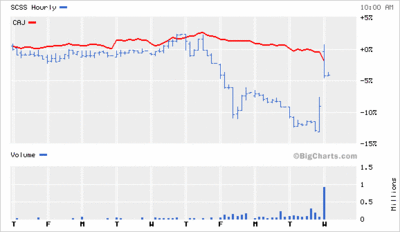Canon is currently trading at about $49.50 a share, which is just about what ¥5,560 is worth in dollars. (¥112 buys about $1.) Over the past four quarters Canon has earned $3.73. That works out to a P/E ration of about 13. It holds roughly $8.63 a share in net cash and has raised the interim dividend, which strongly suggests the year-end dividend will be raised too. If you use a discount rate of 11%, the current price implies a growth rate of 1.8%. But earnings have grown 20% a year over the past 10 years. My dicount cash flow model suggests the company is worth $100 or so.
Is Canon cheap because it's a Japanese company that faces greater competition from China? Are investors afraid the Yen will rise (or fall) dramatically? Is there some risk Canon executives are running an Enron-style fraud? I just don't understand.
Update (August 5): A Standard & Poor's stock report has one possible answer.
We recently reduced our opinion on the shares to hold, from strong buy, after the company posted second quarter earnings per ADR of $0.82, lower than our estimate of $0.86. Revenues grew by 7%, but gross margins narrowed by 234 basis points compared to a year earlier. Although CAJ's cost structure has improved relative to competitors, its second half guidance indicates that it is not immune to declining selling prices of printers, copiers, and digital still cameras.
Here's the breakdown of Canon's revenue by segment for Q2, 2005:
Sales by product Q2, 2005 Q2, 2004 Change (%) Business machines: Office imaging products ¥ 292,716 ¥ 284,938 + 2.7 Computer peripherals 285,445 269,890 + 5.8 Business information products 25,316 28,119 - 10.0 Cameras 219,241 190,108 + 15.3 Optical and other products 89,755 77,313 + 16.1 ----- --------- --------- ------ Total ¥ 912,473 ¥ 850,368 + 7.3 ===== ========= ========= ======
The problem is that the three biggest segments are also becoming lower margin bussinesses according to S&P. For instance, operating profit on Business Machines sunk from 21.3% to 19.7%. Worse, Canon had originally projected an increase to 22.7%. Cameras, meanwhile, earned about 17%. Optical and other products had operating profits in the single digits. So margins are clearly a concern.
The bottom line is that Canon is a premiere company is several tough industries. If they are going to keep up earnings growth, they're going to have to steer costumers to higher margin products (color copiers and printers versus monochrome, and SLR cameras versus point-and-shoot). Also, Canon has to be on the lookout for new products like its flat-screen TV initiative. Canon has benefited from the recent shift from film to digital cameras, but that shift will eventially run out of steam. When it does, I'm confident Canon will be ready for what's next.


